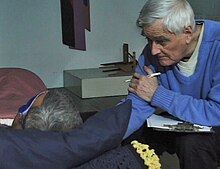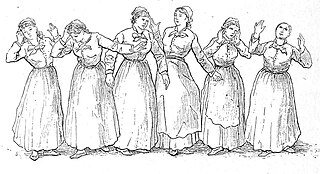
Hypnoanalysis is the technique of using hypnosis in the practice of psychoanalysis and psychotherapy. [1] It attempts to utilize the trance state induced by hypnosis to effect a conscious understanding of a person's unconscious psychodynamics. [2]

Hypnoanalysis is the technique of using hypnosis in the practice of psychoanalysis and psychotherapy. [1] It attempts to utilize the trance state induced by hypnosis to effect a conscious understanding of a person's unconscious psychodynamics. [2]
Hypnoanalysis is derived from the prefix hypno, which the French Étienne Félix d'Henin de Cuvillers first used to describe the hypnotic state. [3] The term hypnoanalysis was coined by James Arthur Hadfield, who claimed that he invented the term to describe the use of hypnosis to retrieve memories, particularly among patients who have amnesia. [4] Other authors who contributed to its development include psychoanalyst Lewis Wolberg and German psychologist Erika Fromm. [5] Fromm is particularly noted for her collaboration with Daniel Brown and Michael Nash, which produced their works detailing the benefits of hypnoanalysis in the 1980s and 1990s. [6]
Hypnosis in the framework of psychotherapy was used by Freud and Breuer by 1985. Breuer discovered that hypnosis could be used, as a form of therapy, to help a hysterical patient to recall the events that caused their hysteria. Following from this, both Freud and Breuer laid down the fundamental ideologies for psychotherapy today, Cathartic Method and Mechanisms of Repression. Gruenewald [7] (1982) commented on Freud's discoveries and stated that Freud recognised that hypnosis can be used as a way to revive memories whilst the patient is in a trance-like state. Freud's work on hypnosis assisted with his finding on the Principle of Transference. [8] He discovered that during the process of hypnosis, there is an encounter between the past and present version of the individual undergoing hypnosis. Both Freud and Breuer carried out hypnosis treatments, by hypnotizing women, in order to have a better understanding of hypnoanalysis. However, due to the “libidinal” aspect of hypnosis, Freud's wife became jealous therefore, Freud discontinued his work on hypnoanalysis.
The term hypno-analysis was first used by Hadfield [9] during World War I. Before WWI, hypnosis was mainly used to revive experiences that were either repressed or forgotten (Ambrose & Newbold, 1985). However, during WWI, hypnosis began to be used in other ways for example, for patients with amnesia due to war shocks (Hadfield, 1920; Brown, 1921). [10] Hypnosis was a frequently used treatment during the time period of the War, as many people had traumatic war experiences, the army hospitals were under a significant amount of pressure so each patient needed to be treated quickly. Brown was the first to realise that during Hypnosis, patients usually had more than one traumatic event that caused their psyche to be weakened. This made psychologists realise that the human mind repressed traumatic memories from the consciousness to prevent hysteria. When Hypnosis was used alongside understanding past traumas, catharsis would be produced, this was useful during treatment. Erickson (1937) explained that for some patients when undergoing hypnosis, they can become unconscious whilst reliving experiences that were traumatic, In 1941, Kubie [11] discovered that during hypnosis, it is possible to alter existing memories.
Erickson and Kubie (1941) used hypnosis as a cure for acute hysterical depression. [12] The patient would firstly be hypnotised and given “protective suggestions” [13] and in order to prevent guilt, the treatment would be followed up by posthypnotic amnesia. This became the procedure that future therapists began to follow. During World War II, the use of hypnosis as a treatment for war for neuroses became popular. In the neuropsychiatric clinic of the Army general hospital, Buckley (1950) noticed that 9 of 22 cases of head trauma with an “alteration of consciousness [14] ” were treated using hypnosis for a time period of 1 to 15 weeks and the treatments were successful. The use of hypnosis to cure war traumas was particularly effective as the treatment was short and the trauma took place recently during adulthood. Later on in 1949, Walkins [15] put forward his “in-and-out” method. [16] In order to help patients (with war shocks and traumas), Walkins would take the patient out of their hypnotic state 12-15 times within one session that lasts roughly an hour long. Walkins carried out this new method of hypnosis as it would help the patient integrate the unconscious and conscious mind.
Hypnosis is usually carried out with the help of a therapist using the technique of either mental images or verbal repetition. When undergoing hypnoanalysis, patients are usually more open to changes as they are put in a trance-like state of relaxation.
Hypnosis in modern-day is usually used to reduce a patient's stress and/or anxiety before they undergo procedures such as breast biopsy. Other conditions that use hypnosis as treatment include: pain control (pains such as cancer, childbirth, irritable bowel syndrome and fibromyalgia), changing unhealthy behaviors such as overeating, insomnia and smoking, hot flashes associated with menopause and can be used to ease the side effects for cancer treatments such as chemotherapy.
Hypnoanalysis is often used with the intention of uncovering repressed memories in therapy patients. It can be used for direct recall or in more indirect ways that involve other therapeutic approaches such as drawing and free writing. [17] A technique used in hypnoanalysis called the "affect bridge" differs from treatment during regular psychoanalysis. Whereas psychoanalysis may use similar ideas to connect older events, an affect bridge helps the client remember an older memory by recalling other memories that have the same associated emotion. [18] Some patients have reported that when they regress to a memory from much earlier in life, that they feel their body returns to its correct chronological age. This can cause them to feel young and small. [19]
Hypnosis treatments can cause unwanted side effects, although rare, some patients experience adverse reactions to hypnosis either straight after the treatment or a few days later. Side effects when undergoing hypnosis therapy include: being anxious of the process when being induced, having trouble awakening from their dream-like state and possible time distortions.[ citation needed ] More general side effects for patients include: drowsiness, distress, headaches, dizziness and the creation of false memories. For patients with psychosis, clinical depression and hysterical disorders, using hypnosis as a form of therapy is not recommended as they may become agitated.[ citation needed ] Patients may fall asleep during treatments if they do not rest well beforehand.

Dianetics is a set of pseudoscientific ideas and practices regarding the metaphysical relationship between the mind and body created by science fiction writer L. Ron Hubbard. Dianetics is practiced by followers of Scientology and the Nation of Islam.
Hypnotherapy is a type of mind–body intervention in which hypnosis is used to create a state of focused attention and increased suggestibility in the treatment of a medical or psychological disorder or concern. Popularized by 17th and 18th century psychologists such as James Braid and Milton H. Erickson.
Psychoanalysis is a set of theories and therapeutic techniques that deal in part with the unconscious mind, and which together form a method of treatment for mental disorders. The discipline was established in the early 1890s by Sigmund Freud, whose work stemmed partly from the clinical work of Josef Breuer and others. Freud developed and refined the theory and practice of psychoanalysis until his death in 1939. In an encyclopedia article, he identified the cornerstones of psychoanalysis as – "the assumption that there are unconscious mental processes, the recognition of the theory of repression and resistance, the appreciation of the importance of sexuality and of the Oedipus complex." Freud's students Alfred Adler and Carl Gustav Jung developed offshoots of psychoanalysis which they called individual psychology (Adler) and Analytical Psychology (Jung), although Freud himself wrote a number of criticisms of them and emphatically denied that they were forms of psychoanalysis. Psychoanalysis was later developed in different directions by neo-Freudian thinkers, such as Erich Fromm, Karen Horney, and Harry Stack Sullivan.
Dissociative identity disorder (DID), previously named multiple personality disorder and commonly referred to as split personality disorder or dissociative personality disorder, is a member of the family of dissociative disorders classified by the DSM-V, DSM-V-TR, ICD 10, ICD 11, and Merck Manual for diagnosis. Dissociative identity disorder is characterized by primarily dissociative disorder symptoms, secondary key symptoms are shared with complex PTSD, Borderline and Schizotypal Personality disorders and tertiary key symptoms are shared with fibromyalgia, sleep disturbances, eating disorders, and body dysmorphic symptoms. Personality states alternately show in a person's behavior; however, presentations of the disorder vary. Dissociative identity disorder is usually caused by excessive and unendurable stress and or trauma, which commonly happens in childhood. The sense of a unified Identity develops from a variety of experiences and sources. In a child who is overwhelmed, the factors that should've blended together or become integrated overtime instead remain separate. Childhood adversity and abuse often leads to the development of dissociative identity disorder, but not exclusively.
Neurosis is a term mainly used today by followers of Freudian thinking to describe mental disorders caused by past anxiety, often that has been repressed. This concept is more usually known today as psychological trauma.
Psychoanalytic theory is the theory of personality organization and the dynamics of personality development relating to the practice of psychoanalysis, a clinical method for treating psychopathology. First laid out by Sigmund Freud in the late 19th century, psychoanalytic theory has undergone many refinements since his work. The psychoanalytic theory came to full prominence in the last third of the twentieth century as part of the flow of critical discourse regarding psychological treatments after the 1960s, long after Freud's death in 1939. Freud had ceased his analysis of the brain and his physiological studies and shifted his focus to the study of the psyche, and on treatment using free association and the phenomena of transference. His study emphasized the recognition of childhood events that could influence the mental functioning of adults. His examination of the genetic and then the developmental aspects gave the psychoanalytic theory its characteristics. Starting with his publication of The Interpretation of Dreams in 1899, his theories began to gain prominence.

Hysteria is a term used colloquially to mean ungovernable emotional excess and can refer to a temporary state of mind or emotion. In the nineteenth century, female hysteria was a commonly diagnosed physical illness in both men and women. It is assumed that the basis for diagnosis operated under the belief that women are predisposed to mental and behavioral conditions; an interpretation of sex-related differences in stress responses. In the twentieth century, it shifted to being considered a mental illness. Many influential people such as Sigmund Freud and Jean-Martin Charcot dedicated research to hysteria patients.
Dissociation, as a concept that has been developed over time, is a wide array of experiences, ranging from a mild emotional detachment from the immediate surroundings, to a more severe disconnection from physical and emotional experiences. The major characteristic of all dissociative phenomena involves a detachment from reality, rather than a loss of reality as in psychosis.

Conversion disorder (CD), or functional neurologic symptom disorder, is a diagnostic category used in some psychiatric classification systems. It is sometimes applied to patients who present with neurological symptoms, such as numbness, blindness, paralysis, or fits, which are not consistent with a well-established organic cause, which cause significant distress, and can be traced back to a psychological trigger. It is thought that these symptoms arise in response to stressful situations affecting a patient's mental health or an ongoing mental health condition such as depression. Conversion disorder was retained in DSM-5, but given the subtitle functional neurological symptom disorder. The new criteria cover the same range of symptoms, but remove the requirements for a psychological stressor to be present and for feigning to be disproved. ICD-10 classifies conversion disorder as a dissociative disorder while DSM-IV classifies it as a somatoform disorder.

Pierre Marie Félix Janet was a pioneering French psychologist, physician, philosopher, and psychotherapist in the field of dissociation and traumatic memory.
The Talking Cure and chimney sweeping were terms Bertha Pappenheim, known in case studies by the alias Anna O., used for the verbal therapy given to her by Josef Breuer. They were first published in Studies on Hysteria (1895).

Studies on Hysteria is an 1895 book by Sigmund Freud, the founder of psychoanalysis, and the physician Josef Breuer. It consists of a joint introductory paper ; followed by five individual studies of hysterics – Breuer's famous case of Anna O., seminal for the development of psychoanalysis, and four more by Freud— including his evaluation of Emmy von N— and finishing with a theoretical essay by Breuer and a more practice-oriented one on therapy by Freud.
Recovered-memory therapy (RMT) is a catch-all term for a controversial and scientifically discredited form of psychotherapy that critics say utilizes one or more unproven therapeutic techniques to purportedly help patients recall previously forgotten memories. Proponents of recovered memory therapy claim, contrary to evidence that traumatic memories can be buried in the subconscious and thereby affect current behavior, and that these memories can be recovered through the use of RMT techniques. RMT is not recommended by mainstream ethical and professional mental health associations.
Abreaction is a psychoanalytical term for reliving an experience to purge it of its emotional excesses—a type of catharsis. Sometimes it is a method of becoming conscious of repressed traumatic events.

Insight-oriented psychotherapy is a category of psychotherapies that rely on conversation between the therapist and the client. It involves developing the patient's understanding of past and present experiences, how they are related to each other and the effect they have on the patient's interpersonal relationships, emotions and symptoms. Insight-oriented psychotherapy can be an intensive process, wherein the client must spend multiple days per week with the therapist.
The hypnoid state is a theory of the origins of hysteria published jointly by Josef Breuer and Sigmund Freud in their Preliminary communication of 1893, subsequently reprinted as the first chapter of Studies on Hysteria (1895).
The Aetiology of Hysteria is a paper by Sigmund Freud about the sexual abuse of children below the age of puberty and its possible causation of mental illness in adults. Presented in April or May 1896, it is where Freud first outlined his seduction theory.
Michael D. Yapko is a clinical psychologist and author, whose work is focused on the areas of treating depression, developing brief psychotherapies and advancing the clinical applications of hypnosis.
In the nineteenth and early twentieth century, hysteria was a common psychiatric diagnosis made primarily in women. The existence and nature of a purported male hysteria was a debated topic around the turn of the century. It was originally believed that men could not suffer from hysteria because of their lack of uterus. This belief was discarded in the 17th century when discourse identified the brain or mind, and not reproductive organs, as the root cause of hysteria. During World War I, hysterical men were diagnosed with shell shock or war neurosis, which later went on to shape modern theories on PTSD. The notion of male hysteria was initially connected to the post-traumatic disorder known as railway spine; later, it became associated with war neurosis.
Lewis Robert Wolberg was an American psychoanalyst. He advocated the use of hypnoanalysis in psychiatric treatment. He wrote or edited 20 books, and in 1945 founded the Postgraduate Center for Mental Health in New York City.